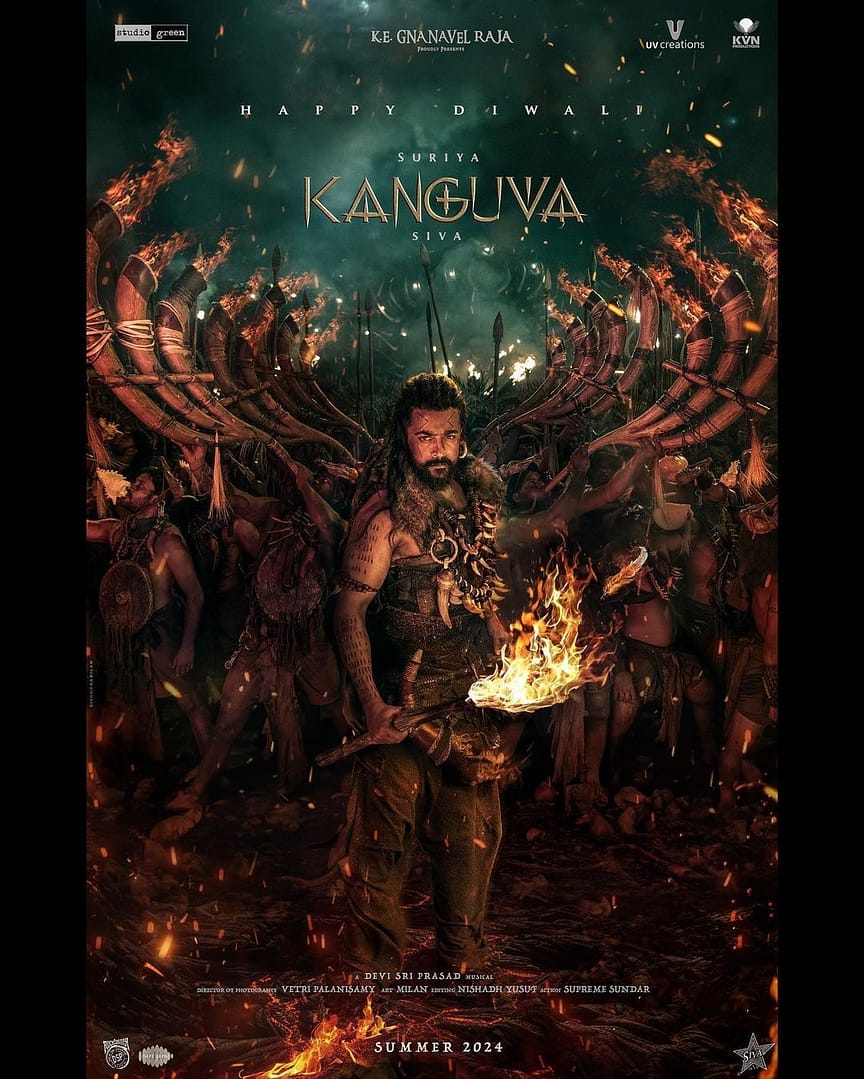Kanguva is an epic fantasy action film directed by Siva, released in Tamil in 2024. An ethnic warrior in 1070 comes aboard with a bounty hunter’s tale in 2024. Show promise initially, the movie has failed miserably at the box office so far, grossing about ₹64.40 crores within eight days, when the approximate budget for the movie is over ₹300 crores, making the producers suffer a big loss of money 234. In return, Suriya has offered to collaborate on a new project to help mitigate the financial fallout that results from the poor performance of the film.
#Summary of “Kanguva”
Director: Siva
Starring: Suriya
Release Year: 2024
Genre: Epic Fantasy Action
#Plot Summary
Kanguva” is a Tamil ambitious film blending two stories: the first one is in 1070 revolving around the story of a tribal warrior, and the second is set in 2024, a bounty hunter’s story. The double storyline runs around valor, heritage, and confrontation over time.
#Box Office Performance
Despite great expectations and a whopping budget of more than ₹300 crores, “Kanguva” has not done well at the box office. The film managed to rake in around ₹64.40 crores within its first eight days, thus causing huge losses to the producers.
#Response to Performance
Given that the film has not been doing well in terms of earning, Suriya has announced working on another film as a way of mitigating the losses incurred following “Kanguva”.
#Conclusion
Since “Kanguva” was believed to be the forerunner of massive films, the box office result raises several worrying lights on whether it is feasible and whether there will be more grand productions in the industry.
#What were the themes most explored in Kanguva?
#Kanguva” explores a few critical themes:
Cultural Heritage and Identity: This movie focuses on preserving the richness of cultural heritage in defiance of foreign exploitation as reflected in Kanguva’s fight to protect his clan and identity in both timelines.
Connectivity Over Time: The plot brings together the stories of Francis and Kanguva, in which the themes of reincarnation and the connections that may exist beyond time and geography.
Heroism and Sacrifice: The crux of this story is the theme of loyalty with Kanguva’s plan to save a young boy, the idea on loyalty and sacrifice in times of need.
It tells a story of tribal wars and personal revenge, spirals of violence and retribution between warring clans.
#Discuss the meaning of parallel timelines in the movie “Kanguva.”
The parallel timelines in the movie “Kanguva” serve several very important purposes:
-Across Time: The film includes a connection between Kanguva, the tribal warrior of the year 1070 and Francis who is a bounty hunter for the year 2024. The film that seems to have deployed themes of reincarnation or destiny and their entangled destinies illustrate how past acts relate in the present which speaks to the continuity of identity and purpose across generations.
-Cultural Heritage and Conflicts: This includes the inborn conflicts between the two tribes in comparison with the present situation. The movie points out how one needs to safeguard their cultural heritage from foreign invasions. That is to say, the dichotomy relates to the issues of identity and survival in both instances.
-The timelines add depth to the narrative by providing a broader context for motivations for the characters and the conflict. The historical context can allow the theme of heroism, sacrifice, and the legacies’ impact on current choices develop much deeper.
-The contrasting settings make the film not only visually appealing but also thematically complex, so the audiences begin to involve themselves in the primitive and modern aspects of human experience as it explores universal love, loyalty, and protection.
READ ALSO: 15 Best places in Europe for a perfect family trip
READ ALSO: Top 15 best things to do in Seattle (2024)
#How does the two timeline structure affect the pacing of the film?
-The dual timeline structure in “Kanguva” significantly affects the film’s pacing by creating a dynamic rhythm that alternates between the past and present. This approach maintains audience engagement through:
-Suspense and Tension: Switching between timelines can heighten suspense, as viewers anticipate how past events will influence current outcomes, keeping the narrative engaging and fast-paced.
-Emotional Resonance: The emotional flow of each timeline must match so that changes in mood and the overall feel helps to advance the story .
-Depth and Complexity: Where two different stories are written together as one, character development and themes are intensified yet not over the top enough to make a film overly bogged down .
-No Filler: The scenes in the two timelines should advance the plot to avoid being a filler that would break the tempo and interest of the viewer.
Dual timelines create interplay that enhances both pacing and narrative depth in “Kanguva.”
#How do the dual timelines create suspense and tension?
-The dual timelines of the film “Kanguva” are suspenseful and tense-making because of the following mechanisms:
–Connected Revelations: What happens in one timeline obviously has great importance for the other. The show creates much tension for suspense when all this is built up around anticipation about how past actions will decide current circumstances .
-Cliffhangers and Transitions: At strategic parts of the film, the movie intentionally switches between timelines. This way, just when one storyline reaches a cliffhanger; it shifts over to the other. This pattern of the movie keeps the viewers awake because they need to return to the unmet situations.
-Foreshadowing: Past timeline will also build up to foretell future events due to inevitability and tension because viewers see how choices from the past impact current situations .
-Character Development: This would have created character development since characters navigated through dilemmas in both timelines; experience continues to mold actions and decisions, hence the tension over their destinies builds and grows investment into the characters’ journeys .
That main storyline of “Kanguva” intertwines suspense and tension through the time-hopping structure, so complexifying the narrative.
#What makes a successful timeline crossover?
To make a successful timeline crossover, as in that of “Kanguva,” the following components are pretty much enough:
Clear Story Reason: Each transition must have a logical reason for occurring to allow smooth movement from one time frame to another, enabling additional character growth or depth of theme.
Fluid Multisensory and Visual Transitions: Auditory and visual transitions such as color grade or set design can help depict transitions across timeline edges and ease audience adjustment.
Good Character Continuity: The more well-connected the arcs of character are between timelines, the easier it is to feel related to the unfolding journey and be emotionally invested in the characters’ presence and transitions.
Good Pacing: Timing for smooth transitions, especially when the tension builds high or revelation moments happen, can be set at great suspense, keeping the audience invested and ensuring the most important elements within each timeline are woven into the overall narrative.
Foreshadowing and Echoing: Engender elements in one timeline to where it will resonate in the other; produce an anticipation that makes the audience want to connect and invest more in the developing narrative.
Together, these elements ensure that smooth transitions are steeped in enrichment of the storyline.
#What are the key elements of a successful transition plan?
Some of the essential elements of a good transition plan include:
Scope and Objectives: Clearly define the purpose, goals, and expected outcomes of the transition, ensuring they align with organizational values and are measurable (SMART criteria) .
Roles and Responsibilities: Assign specific roles to team members, detailing their tasks, authority, and accountability to facilitate effective collaboration .
Activities and Timelines: Outline key steps, milestones, and deadlines for the transition process to maintain focus and ensure timely execution .
Risk Management: Set out the challenges and mitigation strategies before them, ensuring that stakeholders are alerted .
Communication Plan: Plan for engaging stakeholders in all processes: key messages to be conveyed and through what channels to build trust and ensure cooperation.
Monitoring and Evaluation: Setting up metrics for measuring their progress and success to better course correct and pay heed to achievements along the way.
#What are the best practices for communication of transition plans to employees?
Effective communication of transition plans to employees encompasses various best practices listed below:
Share a Clear Vision: Explain the benefits of the transition to both the organization and employees which will improve operations and individual experiences.
Unified Message Set a core message: Explain what is changing, why it matters and how it benefits everyone. Ensure it is short and clear in all channels of communication.
Use of Multiple Communication Channels Use many types of channels like team meetings, emails, or one-on-one talks to reach different audiences effectively to cater to various preferences .
Engage Employees: Involve questions and feedback either through forums or town hall. This helps to address concerns as well as build trust.
Tailor Communication: Messages ought to be tailored based on the specific impact of any communication on different roles or departments. The key questions like “What’s in it for me?”.
Develop Champions: Train managers to share information and resources about the change with internal champions so that they can cascade down the news to their teams.
Listen Feedback: Pay attention to employees’ reactions toward the information received and be responsive in making changes to clarify and reassert support while transition happens . Through such practices, organizations can create improved understanding and understanding of the organizational change, reduce resistance to change and create a supportive atmosphere during the transition.






Altayçeşme su kaçak tespiti Sultangazi’deki evime hizmet veren ekip çok hızlıydı, su kaçağını hemen tespit ettiler. https://konnek.social/ustaelektrikci